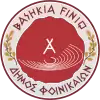Finiq
Finiq (Albanian: Finiq or Finiqi, Greek: Φοινίκη, Finiki) is a predominantly Greek-inhabited settlement, considered town or village,[1][2][3] and municipality in Vlorë County, in southern Albania located 8 km from the Ionian Sea and 20 km north of the Greek border. It was formed at the 2015 local government reform by the merger of the former municipalities Aliko, Dhivër, Finiq, Livadhja and Mesopotam, that became municipal units. The seat of the municipality is the village Dermish.[4] The total population is 10,529 (2011 census),[5] in a total area of 444.28 km2.[6]
Finiq
Φοινίκη (Finiki) | |
|---|---|
 The highlands of Delvinë and the hill of Finiq, ancient Phoinike, in the center of the picture behind the plains. | |
 Emblem | |
 Finiq | |
| Coordinates: 39°54′N 20°3′E | |
| Country | |
| County | Vlorë |
| Government | |
| • Mayor | Kristo Kiço (Greek Ethnic Minority for the Future (M.E.G.A)) |
| Area | |
| • Municipality | 444.28 km2 (171.54 sq mi) |
| Population (2011) | |
| • Municipality | 10,529 |
| • Municipality density | 24/km2 (61/sq mi) |
| • Municipal unit | 1,333 |
| Time zone | UTC+1 (CET) |
| • Summer (DST) | UTC+2 (CEST) |
| Postal Code | 9716 |
| Area Code | (0)895 |
| Website | Official Website |
The population of the former municipality at the 2011 census was 1,333,[5] however according to the civil offices was 6,780 (2011 estimate).[7]
Demographics
The 2015 Albanian civil registry recorded a much higher municipal population of 39,055.[7] The municipal unit of Finiq comprises the villages Finiq, Buronjë (Mavropull), Çlirim, Vrion, Karahaxhë and Bregas (Vromero).[8] Finiq and all the villages of the municipality are solely inhabited by Greeks, except the village of Çlirim, which is mixed.[9][10]
History
In antiquity, Phoenice was the political center of the Epirot Greek tribe of the Chaonians. Early Byzantine architecture (4th-7th century) is evident in the settlement in particular that of the three aisled basilica type.[11]
The settlement retained its ancient name and is mentioned in an Ottoman record of 1431 as Finiki.[12] According to the Chronicle of Gjirokaster the first years of Ottoman rule (15th century) were peaceful but after the Fall of Constantinople (1453) Finiki (that time known as Phinikoupolis) was destroyed by the Muslims.[13] At the end of the 16th century Finiki witnessed a drastic population increase and became one of the largest settlements in the area with 359 households (compared to contemporary Gjirokastër with 302 and Delvine with only 204 taxable households).[14]
At 1870 a secondary Greek language school was already operating in Finiq.[15]
References
- Spiro Shkurti (2002). Bujqësia në Arbërinë e shek. XIII-XVII. Akademia e Shkencave e Shqipërisë Instituti i Kulturës Popullore. p. 60.
Për të krijuar bindje për këtë mjafton të shënojmë se në fshatin Finiq (Delvinë), psh, nga 359 burra në moshë madhore (kryefamiljarë) që kishte në fund të shekullit XVI, vetëm 6 persona ishin të ardhur, pra, vetëm 1,6% e të gjithë popullsisë së vendbanimit.
- Akademia e Shkencave e RPS të Shqipërisë; Fjalori enciklopedik shqiptar (1985). Fjalor enciklopedik shqiptar. Akademia e Shkencave e RPSSH. p. 260.
FINIQI. Fshat në rrethin e Sarandës (L), në rrë- zën P të malit të Finiqit.
- Gillian Gloyer (7 January 2015). Albania. Bradt Travel Guides. p. 228. ISBN 978-1-84162-855-4.
The modern village of Finiqi is on a minor road which links the Saranda–Delvina road and the main Saranda-Gjirokastra road.
- Law nr. 115/2014
- "Population and housing census - Vlorë 2011" (PDF). INSTAT. Retrieved 2019-09-25.
- "Correspondence table LAU – NUTS 2016, EU-28 and EFTA / available Candidate Countries" (XLS). Eurostat. Retrieved 2019-09-25.
- "Vlora's communes". Retrieved 13 January 2016.
- Greece – Albania Neighbourhood Programme Archived March 27, 2012, at the Wayback Machine
- Kallivretakis, Leonidas (1995). "Η ελληνική κοινότητα της Αλβανίας υπό το πρίσμα της ιστορικής γεωγραφίας και δημογραφίας [The Greek Community of Albania in terms of historical geography and demography." In Nikolakopoulos, Ilias, Kouloubis Theodoros A. & Thanos M. Veremis (eds). Ο Ελληνισμός της Αλβανίας [The Greeks of Albania]. University of Athens. p, 31, 54; p. 51. "Μ Μικτός πληθυσμός"; p.54. "ΣΜΤ (ΜΤΣ) 569 Μ".
- Badlands-Borderland: A History of Southern Albania/Northern Epirus by T.J. Winnifrith,ISBN 0-7156-3201-9,2003,Page 69,"... 16. Greek-speaking children in modern Finiq ..."
- Giakoumis, 2002, p. 123
- Kyriazis, Doris (2019). "Διατοπικότητα και διαχρονικότητα των νεοελληνικών γλωσσικών ιδιωμάτων της νότιας Αλβανίας". Proceedings of the International Conference Series of Modern Greek Dialects and Linguistic Theory. 8: 122. doi:10.26220/mgdlt.v8i1.3010. Retrieved 24 August 2020.
- Giakoumis, 2002, p. 71
- Giakoumis, 2002, p. 54
- Koltsida, Athina (2008). Η Εκπαίδευση στη Βόρειο Ήπειρο κατά την Ύστερη Περίοδο της Οθωμανικής Αυτοκρατορίας [Education in Northern Epirus during the Latter Ottoman Period] (pdf) (in Greek). Aristotle University of Thessaloniki. p. 187. Retrieved 16 December 2012. (PhD Thesis)
Sources
- Konstantinos., Giakoumis (2002). "The monasteries of Jorgucat and Vanishte in Dropull and of Spelaio in Lunxheri as monuments and institutions during the Ottoman period in Albania (16th-19th centuries)". University of Birmingham. Retrieved 20 May 2018. Cite journal requires
|journal=(help)


